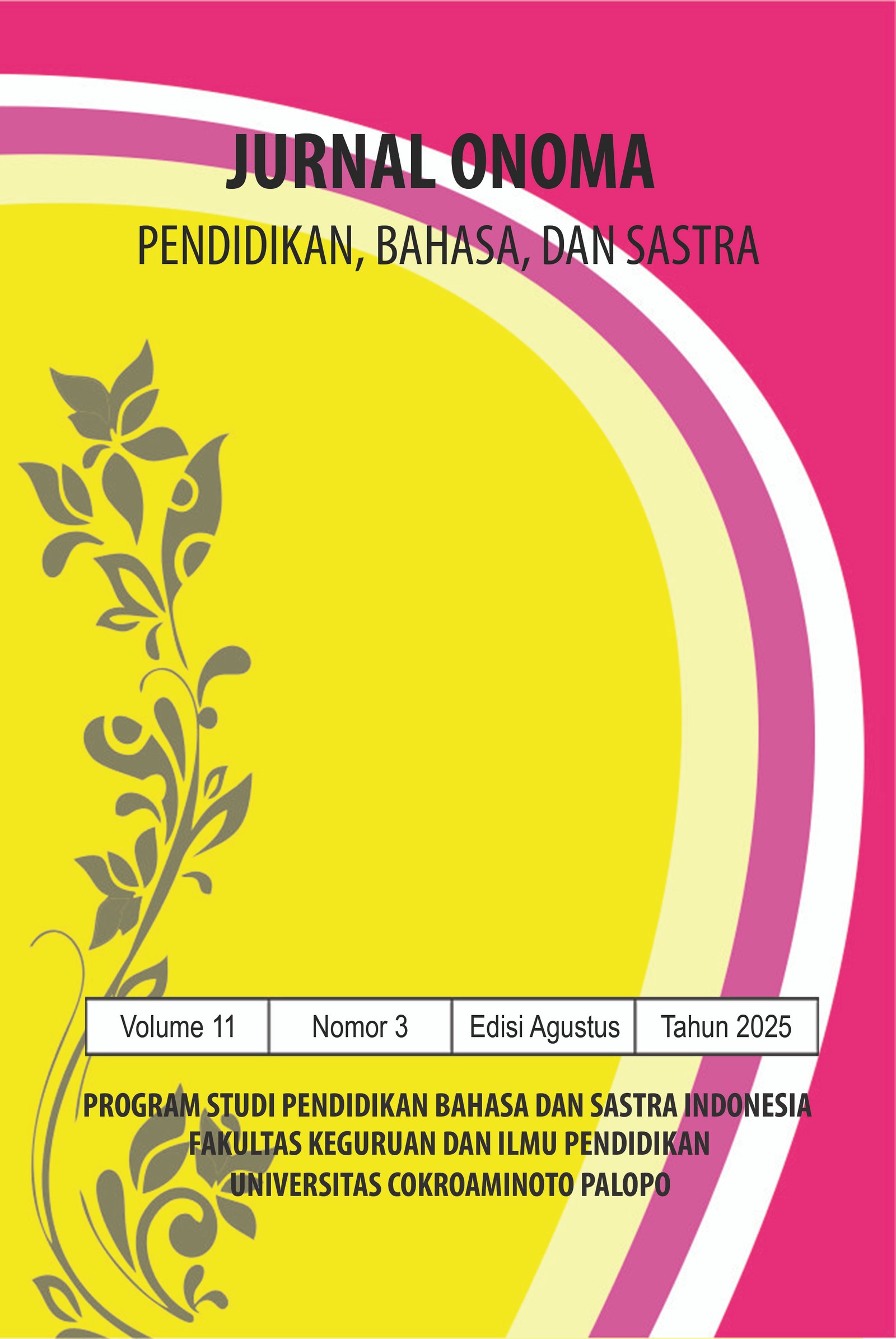Konsep Metafora Lakoff dan Johnson dalam Tayangan Youtube Pandji Pragiwaksono Berjudul “Dinasti Pasti Buruk untuk Negeri”
https://doi.org/10.30605/onoma.v11i3.5886
Keywords:
metafora, dinasti, politik, YoutubeAbstract
Penelitian ini bertujuan untuk (1) menganalisis pemakaian metafora dalam tayangan video Youtube karya Pandji Pragiwaksono berjudul “Dinasi Pasti Buruk untuk Negeri” menggunakan teori metafora Lakoff dan Johnson dan (2) mendeskripsikan jenis-jenis metafora dalam tayangan video Youtube karya Pandji Pragiwaksono berjudul “Dinasti Pasti Buruk untuk Negeri” menggunakan teori Lakoff dan Johnson. Penelitian ini merupakan penelitian deksriptif kualitatif, yang penelitian yang bersifat deskripsi. Sumber data penelitian ini yaitu tayangan video Youtube karya Pandji Pragiwaksono berjudul “Dinasti Pasti Buruk untuk Negeri”. Data dalam penelitian ini berupa ungkapan yang disampaikan oleh Pandji Pragiwaksono dalam videonya. Hasil penelitian ini ditemukan dua jenis metafora yang digunakan yaitu metafora struktural dan metafora ontologis. Metafora merupakan penggunaan ungkapan atau kata yang mengandung makna kiasan. Metafora struktural digunakan untuk menggambarkan satu konsep menggunakan konsep yang lain, sedangkan metafora ontologis berkaitan dengan proses mental yang terdapat dalam ungkapan yang digunakan oleh Pandji Pragiwaksono. Metafora dianalisis sesuai dengan domain sumber dan domain sasaran. Metafora yang dihadirkan cukup sering digunakan dalam kehidupan sehari-hari untuk meyakinkan pemirsa terkait argumen yang diungkapkan oleh Pandji Pragiwaksono.
Downloads
References
Alek. (2018). Linguistik Umum. Penerbit Erlangga.
Dung, T. T. Le. (2025). Conceptual Metaphors of Life in Selected Contemporary British Novels. Theory and Practice in Language Studies, 15(3), 869–878. https://doi.org/10.17507/tpls.1503.22
Eliani, J., Yuniardi, M. S., & Masturah, A. N. (2018). Fanatisme dan Perilaku Agresif Verbal di Media Sosial pada Penggemar Idola K-Pop. Psikohumaniora: Jurnal Penelitian Psikologi, 3(1), 59–72. https://doi.org/10.21580/pjpp.v3i1.2442
Goatly, A. (2005). The Language of Metaphors. Routledge.
Harjanti, F. D., Kaswadi, & Damayanti, R. (2022). Metafora dalam Meme Ucapan Selamat Pagi di Media Sosial. Ranah: Jurnal Kajian Bahasa, 11(1), 221–231. https://doi.org/https://doi.org/10.26499/rnh.v11i1.4862
Hills, M. (2013). Foreword What if ? – Reimagining Fandom. Aberystwyth University.
Lakoff, G., & Johnson, M. (1980). Metaphors We Live By. The University of Chicago Press.
Lubis, S., & Siregar, B. U. (1985). Pengantar linguistik umum. Pusat Pembinaan dan Pengembangan Bahasa Departemen Pendidikan dan Kebudayaan.
Miles, M. B., Huberman, A. M., & Saldana, J. (2014). Qualitative Data Analysis A Methods Sourcebook. SAGE Publications.
Miswaty, T. C., & Sumadewi, N. K. P. N. (2024). Nyanyian Tradisi Lisan Masyarakat Sasak dalam Kajian Metafora Kognitif. STILISTIKA: Jurnal Bahasa Dan Sastra, 17(2), 237–246. https://doi.org/http://dx.doi.org/10.30651/st.v17i2.22685
Muhid, A., Syamsurrijal, Miswaty, T. C., Hadi, Z. P., Sudewi, N. K. P. N., & Syahid, A. (2023). Pengantar Pembelajaran Ilmu Linguistik. CV. Insan Kreasi Media.
Nirmala, D. (2012). Metaphorical Forces of Expressions in Letters to The Editors in Bahasa Indonesia. Humaniora, 24(2), 211–220. https://doi.org/https://doi.org/10.22146/jh.1063
Pardede, P. (2013). Penerjemahan Metafora. Eed Collegiate Forum Universitas Kristen Indonesia, December 2013, 1–10. https://www.researchgate.net/publication/259469138_Penerjemahan_Metafora
Pertiwi, S. A. (2013). Konformitas dan Fanatisme pada Remaja Korean Wave. Psikoborneo: Jurnal Ilmiah Psikologi, 1(2), 84–90. https://doi.org/10.30872/psikoborneo.v1i2.3286
Salsabila, Q., & Fadhilah, L. D. N. (2022). Analisis Konsumerisme Pasif Para Penggemar Fanatik Idol group BTS di Kediri dalam Pembelian Merchandise. LoroNG: Media Pengkajian Sosial Budaya, 11(1), 1–16. https://doi.org/10.18860/lorong.v11i1.2106
Santika, W., & Bawono, Y. (2022). Ketidakpuasan Bentuk Tubuh pada Remaja Perempuan Penggemar K-Pop. Gulawentah: Jurnal Studi Sosial, 7(1), 46–55. https://doi.org/10.25273/gulawentah.v7il.12125
Sianturi, N. P., Paulus, J. T., Takasihaeng, M. L. P., Teleng, M., Bowontari, N. F., & Katiandagho, P. A. (2024). Cahaya dalam Kegelapan: Dukungan Spiritual dan Emosional Melalui Konseling Pastoral untuk Anak Tunanetra. Tentiro: Jurnal Pendidikan Dan Kesehatan, 1(2), 1–13. https://doi.org/https://doi.org/10.70420/tentiro.v1i2.69
Sutarni, N. (2024). Pengantar Hukum Indonesia (Kustiyono (ed.)). Eureka Media Aksara.
Ulas, S. C., Calim, S. I., & Cetinkaya, A. (2025). Exploring Turkish women’s gynecological examination perceptions based on their metaphors: a qualitative study. BMC Women’s Health, 25(1), 1–8. https://doi.org/10.1186/s12905-025-03621-6
Undang-Undang Republik Indonesia Nomor 38 Tahun 2004 Tentang Jalan, Pub. L. No. 38, Republik Indonesia 1 (2004).
Downloads
Published
How to Cite
License
In submitting the manuscript to the journal, the authors certify that:
- They are authorized by their co-authors to enter into these arrangements.
- The work described has not been formally published before, except in the form of an abstract or as part of a published lecture, review, thesis, or overlay journal.
- That it is not under consideration for publication elsewhere,
- That its publication has been approved by all the author(s) and by the responsible authorities – tacitly or explicitly – of the institutes where the work has been carried out.
- They secure the right to reproduce any material that has already been published or copyrighted elsewhere.
- They agree to the following license and copyright agreement.
License and Copyright Agreement
Authors who publish with Onoma Journal: Education, Languages??, and Literature agree to the following terms:
- Authors retain copyright and grant the journal right of first publication with the work simultaneously licensed under Creative Commons Attribution License (CC BY 4.0) that allows others to share the work with an acknowledgment of the work's authorship and initial publication in this journal.
- Authors are able to enter into separate, additional contractual arrangements for the non-exclusive distribution of the journal's published version of the work (e.g., post it to an institutional repository or publish it in a book), with an acknowledgment of its initial publication in this journal.
- Authors are permitted and encouraged to post their work online (e.g., in institutional repositories or on their website) prior to and during the submission process, as it can lead to productive exchanges, as well as earlier and greater citation of published work.

















